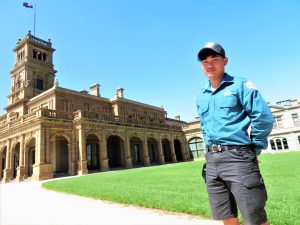Nature-loving refugee finds his place among the gum trees
The steamy jungles of the Thai-Burma border are a world away from the manicured lawns and parterre gardens of Melbourne’s Werribee Park Mansion.
But for young refugee Nay Kaw, the pink flowering hibiscus in the mansion’s formal gardens are link to his homeland and they speak to his love of nature and the outdoors.
The twenty-year-old recently took up a Traineeship in Parks and Gardens with Parks Victoria at Werribee Park, which puts him on a pathway to become just the second refugee Park Ranger in Victoria.
”It is a dream come true for me and a great opportunity. I love the outdoors and to be working in an amazing environment like Werribee Park is amazing,” Nay said.
“I love growing vegetables and gardening at home, so this is a dream job for me,” he said.
 An ethnic Karen, Nay Kaw was born in the Mae La Refugee Camp on the Thai-Burma border where his family fled, along with thousands of other Karen, after facing decades of persecution and ethnic cleansing at the hands of the Burmese government.
An ethnic Karen, Nay Kaw was born in the Mae La Refugee Camp on the Thai-Burma border where his family fled, along with thousands of other Karen, after facing decades of persecution and ethnic cleansing at the hands of the Burmese government.
“Growing up in the camp was hard. It was a difficult time. We were not allowed out of the camp and we were not allowed to work; and sometimes there was not enough food,” he said.
But Nay Kaw was able to attend school where he learned some English as well as maths and science.
“I learned some English but it was hard because there was no one to talk to and practice my English,” he said.
But Nay Kaw’s time in the camp also saw tragedy strike.
“My father went into the jungle near the camp to gather food but he stepped on a land mine and lost his leg,” he said.
In another land mine incident near the camp, Nay Kaw’s uncle lost his eyesight.
Nay Kaw was 15 in 2019 when he and his mother, father and his four siblings arrived in Melbourne.
After receiving support, including on-arrival accommodation, from refugee settlement agency AMES Australia, the family settled in their own home in Laverton.
“When we arrived everything was different and at first I didn’t like it. I spoke little English and couldn’t understand anything or anyone,” he said.
“But after a couple of months I started to enjoy my new life in Melbourne. I met people and started to do things.”
Nay Kaw attended the local English Language School in Werribee before moving to Laverton P-12 College to start Year 10.
He finished his secondary studies last year – much of which was conducted online because of the COVID-19 lockdowns.
Nay Kaw was working casually in a factory when he heard about the opportunity with Parks Victoria from a local community leader.
Nay Kaw’s role model and mentor is by Victoria’s first refugee Park Ranger Hsar Thein Ju, also a Karen from Burma who also grew up in the Mae La camp.
Hsar will be guiding Nay Kawalong the path he himself took eight years ago.
“It is great to see young people from my community getting involved and attempting to realise their dreams.
“My role will be to guide Nay Kaw along the path that I took and achieve what he wants to do into the future,” Hsar said.
Werribee Park Chief Ranger James Brincat says Nay Kaw will have the support of all of the team at the park.
“The traineeship in Parks and Gardens involves formal studies as well as on-site training here at Werribee Park,” James said.
“He will be guided towards taking up an opportunity to become a Park Ranger,” he said.
James said the traineeships provide an alternative pathway for young adults from local emerging communities who otherwise might not be able to access a career as a Park Ranger.
“Traineeships and apprenticeships make these kinds of jobs accessible especially for people from our new and emerging communities and it goes some way to achieving diversity in our workforce so that we are able to interact with our increasingly diverse park visitor base,” he said.
“It’s essentially a partnership program involving Parks Victoria, AMES Australia and GForce Recruitment. AMES provides guidance around working with new and emerging communities and tapping into their skills.”












